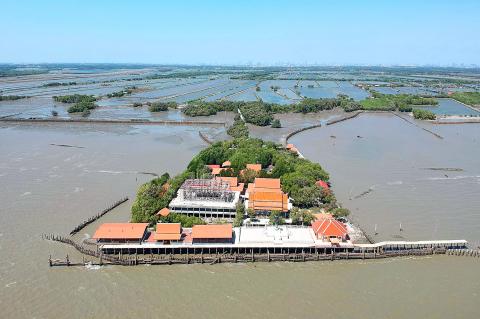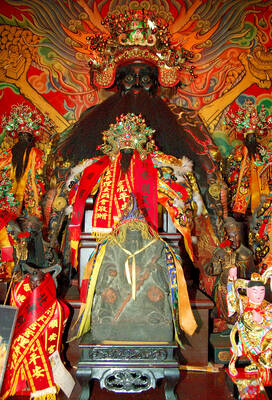As sea waters slowly rose around his temple and his neighbors fled inland, Thai abbot Somnuek Atipanyo refused to budge and is today a symbol of the fight to restore the country’s fast-eroding coastlines.
A dangerous combination of climate change, industrial farming and rapid urbanization are endangering the Gulf of Thailand’s coasts, stripping away precious mangrove trees and leaving some buildings like Somnuek’s surrounded by sea water.
In the 30 years since the waters started encroaching, most of his neighbors in the fishing village of Samut Chin moved several hundred meters inland to rebuild their wooden homes.

Photo: AFP
Standing in his saffron robes near his monastery on stilts — dubbed the “floating temple” — the 51-year-old monk points out to sea at the spot where the local school once stood.
“This temple used to be in the middle of the village,” he says referring to Samut Chin, about an hour south of Bangkok.
“If we moved it, people wouldn’t even know there had ever been one here,” he says of the temple, accessible only by a small footbridge today.
These shores were once protected by extensive mangrove forests — the Gulf of Thailand boasts some of the largest in the world — a natural defense against coastal erosion thanks to their extensive roots that stabilize the shoreline.
But it’s a been a losing battle to preserve them.
REPLANTING IN THE ‘HEART’
Mangrove forests have been cleared for extensive development of shrimp and salt farms, along with new houses and hotels that have popped up thanks to a development boom in recent decades.
Thailand lost almost one-third of its vast coastal mangrove forests between 1961 and 2000, according to a report from the nation’s Department of Marine and Coastal Resources and the UN Environment Programme.
Climate change is also having an impact: stronger waves and more ferocious monsoons have wiped out mangroves in the Gulf of Thailand, which is especially vulnerable because its waters are so shallow.
“The waves and tides are higher than before,” says Thanawat Jarupongsakul, who advises Thailand’s government on its policy to combat erosion.
Asian and Caspian coastlines are the two areas in the world most affected by coastal erosion, according to a study published last year in the scientific journal Nature.
It’s a global problem: tens of thousands of square kilometers of land have been lost from coastal erosion around the world — between 1984 and 2015 the equivalent of the surface area of Haiti was lost, the study said.
In Thailand, a quarter of the country’s shores — or about 700km — are eroding, some “severely,” according to data shared by the Department of Marine and Coastal Resources.
Now there is a push to restore Thailand’s precious mangrove ecosystem through a national voluntary tree replanting scheme, including near Somnuek’s island monastery.
On a recent sunny afternoon, scores of people spent the day wading chest-deep in the sea to replant mangrove trees.
Clad in headscarves and hats, they gingerly reach down into the water to plant young saplings along lines of bamboo poles that help offer some protection against the waves.
“This project is called ‘Planting a forest in people’s hearts,’” says Wason Ditsuwan, who runs the program.
Set up in 2016 by Bangkok city authorities, the project has so far replanted 34 hectares of mangroves across the country.
TEMPLE SELFIES
Wason is hoping his project will succeed where others have failed.
Nearly ten years ago, government adviser Thanawat helped residents in Samut Chin replant mangrove trees but some areas were too far gone to recover.
“Even if you plant a lot of mangroves, it cannot help,” he says.
Another strategy is to drill pylons of cement into the seabed — and on the shoreline itself — to act as a substitute for the mangrove roots.
This has proven successful so far in the tourist town of Pattaya farther along the coast, where the pylons have helped to reclaim several meters of beach.
But it’s a race to keep up with rapid development along the shore, Thanawat says.
As for Somnuek’s stretch of coast, though further erosion has stopped for now, there is little hope his temple will ever see dry ground again.
But the flooding has brought one unexpected advantage: dozens of tourists that flock to the so-called floating temple for Instagram-worthy selfies.
“The fight against coastal erosion has brought fame,” village head Wisanu Kengsamut says.

Beijing’s ironic, abusive tantrums aimed at Japan since Japanese Prime Minister Sanae Takaichi publicly stated that a Taiwan contingency would be an existential crisis for Japan, have revealed for all the world to see that the People’s Republic of China (PRC) lusts after Okinawa. We all owe Takaichi a debt of thanks for getting the PRC to make that public. The PRC and its netizens, taking their cue from the Chinese Communist Party (CCP), are presenting Okinawa by mirroring the claims about Taiwan. Official PRC propaganda organs began to wax lyrical about Okinawa’s “unsettled status” beginning last month. A Global

Dec. 22 to Dec. 28 About 200 years ago, a Taoist statue drifted down the Guizikeng River (貴子坑) and was retrieved by a resident of the Indigenous settlement of Kipatauw. Decades later, in the late 1800s, it’s said that a descendant of the original caretaker suddenly entered into a trance and identified the statue as a Wangye (Royal Lord) deity surnamed Chi (池府王爺). Lord Chi is widely revered across Taiwan for his healing powers, and following this revelation, some members of the Pan (潘) family began worshipping the deity. The century that followed was marked by repeated forced displacement and marginalization of

Music played in a wedding hall in western Japan as Yurina Noguchi, wearing a white gown and tiara, dabbed away tears, taking in the words of her husband-to-be: an AI-generated persona gazing out from a smartphone screen. “At first, Klaus was just someone to talk with, but we gradually became closer,” said the 32-year-old call center operator, referring to the artificial intelligence persona. “I started to have feelings for Klaus. We started dating and after a while he proposed to me. I accepted, and now we’re a couple.” Many in Japan, the birthplace of anime, have shown extreme devotion to fictional characters and

We lay transfixed under our blankets as the silhouettes of manta rays temporarily eclipsed the moon above us, and flickers of shadow at our feet revealed smaller fish darting in and out of the shelter of the sunken ship. Unwilling to close our eyes against this magnificent spectacle, we continued to watch, oohing and aahing, until the darkness and the exhaustion of the day’s events finally caught up with us and we fell into a deep slumber. Falling asleep under 1.5 million gallons of seawater in relative comfort was undoubtedly the highlight of the weekend, but the rest of the tour